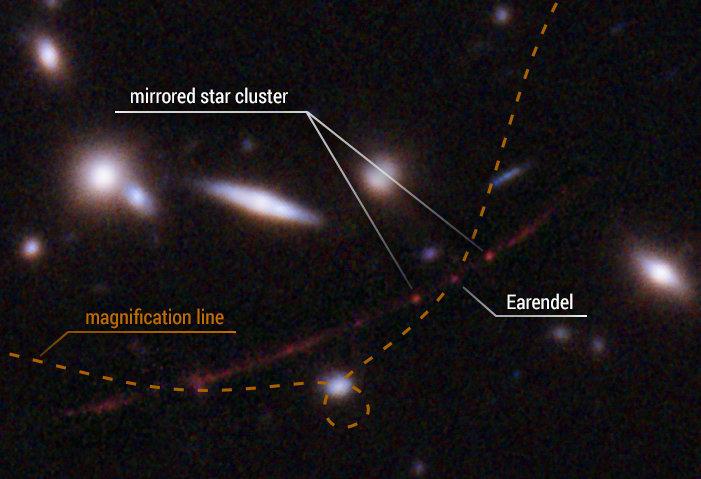
Thanks to its rare alignment with the lenticular galaxy, Erundel Star appears to be very close to the ripples in the structure of space. This ripple provides the maximum magnification, so the brightness of this extremely distant star is magnified thousands of times before it stands out from the general glow of its host galaxy
The most distant star to date
The venerable Hubble Space Telescope has once again broadened the horizons of the universe, this time revealing to mankind the most distant and oldest single star ever seen. This star formed in the nascent universe 9 million years after the Big Bang. Astronomers gave him the title "Elandir" in honor of the English fantasy writer J.R.R. Tolkien), and his own European mythology drawn from Middle-earth stories. Astronomers unveiled the landmark findings on Wednesday, March 30, 2022, during a highly anticipated NASA virtual press conference.
Scientists say Elandir's discovery is more than just a record-breaking achievement at the technical level. This discovery, for both astronomers and cosmologists, provides a unique opportunity to study the environment of the early universe and the composition of the objects that emerged from this epoch.
Distant discoveries reveal the early universe
Hopkins astronomer, Wells Bryan, is the lead author of the paper on revealing the discovery of WHL0137-LS (Erendel's official term is less poetic). Wells expected that further study of this most distant star would make it possible to give us a new and deeper understanding of the characteristics of the universe at some point in time, very different from modern times.
Wells said in an interview:
I think the most interesting thing is that it goes back to a time when the universe was very different from today. So by looking at early galaxies, we can say that they are very different in their construction and very different from the galaxies we see nearby, such as the Milky Way and our nearest neighbor, Andromeda.
So Wells and the other members of the team who discovered Erundel hope that their discovery will teach us more about the evolution of the planets in the early universe, while also revealing the properties of ancient primitive objects. This clearly suggests that so far away stars would also look slightly different.
During a maintenance mission in 2002, the ancient Hubble Space Telescope was deployed from the Space Shuttle Columbia.
Image from NASA.
Hubble and Webb will be a powerful combination
It is unclear what information the oldest star will eventually reveal to astronomers, because this is the first time ever that an ancient star like Elandir has been taken.
Wells explains, so we haven't had the opportunity to study the oldest stars. And I think what interests me the most, and what excites me the most, is that now the opportunity has come, because we have found such a concrete planet with precision, and we can study it in detail.
When Hubble and Webb join forces, the details of Elandir's observations will be more comprehensive. At the same time, joint observations will capture a wider range of spectral information than they would observe alone.
Yes, hubble and Weber telescopes are highly complementary. Hubble observes a shorter band (visible light), while Weber can observe longer wavelengths (infrared). When you use them for joint observations, you'll have a more complete understanding of the celestial bodies you're looking at.
Illustration of gravitational lensing. This phenomenon occurs when massive galaxies are located between us and distant objects. Image from Cfhtlens.org.
In general, Hubble does not observe faint, distant stars like Erundel. But astronomers use the "gravitational lensing" effect to observe, and use other methods to change the direction of the optical path to the observation target many times. Welch and his company were fortunate to encounter such a rare thing. They revealed in an article titled "A Highly Magnified Redshift Star 6."
Related knowledge
The Hubble Space Telescope (commonly referred to as HST or Hubble) is a space telescope that was launched into low-Earth orbit in 1990 and has been in operation ever since. Hubble wasn't the first space telescope, but it was one of the largest and most versatile. It is not only an important tool for astronomical research, but also a gospel for the majority of astronomical enthusiasts. Named after astronomer Ed Hubble, Hubble is one of NASA's greatest observatories. The Space Telescope Science Institute (STScl) selects Hubble's observation targets and processes the resulting data, while the Goddard Space Flight Center (GSFC) controls the spacecraft.
Hubble's key feature is having a 2.4 m (7 ft 10 in) mirror and its 5 main instruments observe in the ultraviolet, visible, and near-infrared regions of the electromagnetic spectrum. Hubble orbits beyond distortion of Earth's atmosphere, allowing it to capture extremely high-resolution images in background light well below ground-based telescopes. It records some of the most detailed images of visible light that can go deep into space. Many of Hubble's observations led to major breakthroughs in astrophysics, such as the determination of the expansion rate of the universe.
BY:Dave Adalian
FY:Astronomical volunteer team
If there is any infringement of the relevant content, please contact the author to delete it after the work is published
Please also obtain authorization to reprint, and pay attention to maintaining completeness and indicating source